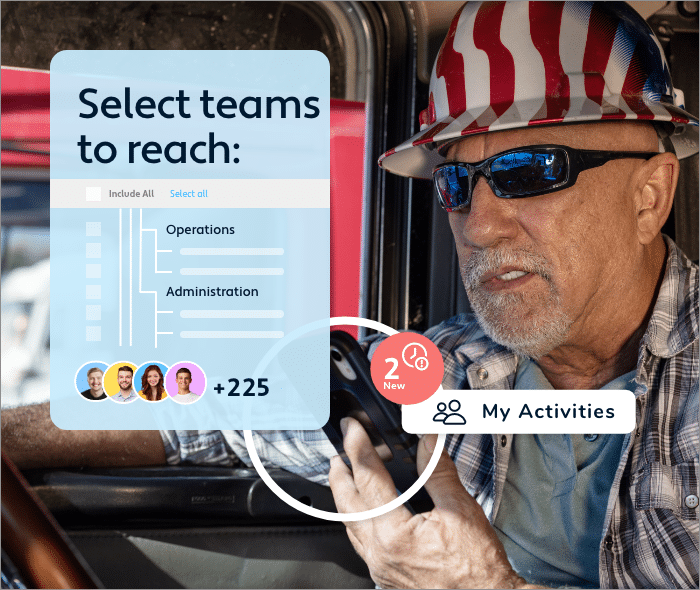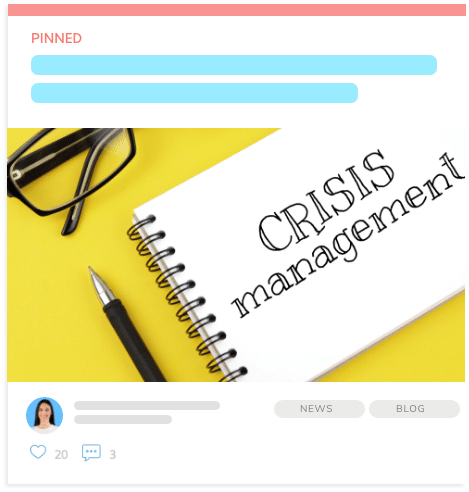EMPLOYEE CRISIS COMMUNICATION SOFTWARE
Shore Up Your Crisis Communication Plan in the Digital Age
When the unexpected happens, are you ready to manage your frontline employees while keeping them safe and motivated? In the digital age, it’s more important than ever to have a crisis communication platform in place for your deskless workforce.

Prepare for the Unexpected
When crisis strikes, be prepared to alert your employees with our crisis communication tool and keep things operating as smoothly as possible. Shore up your crisis response to prepare for any situation.
Remain Productive
Whether it’s a natural disaster or technical failure, you can have a crisis management plan in place to ensure your team remains safe and as productive as possible.
Avoid Confusion
Provide every team member with accurate information they need to avoid confusion in times of crisis. Keep internal communication simple and transparent.

What is a Crisis Communication Strategy?
A crisis communication strategy outlines how your organization will communicate during a crisis. While many teams have plans in place to prevent and mitigate the unexpected, many overlook the importance of planning or communication during these times.
A crisis communication plan outlines who will be in charge of communications, which communication channels will be used, how frequently updates will be provided and more. It can outline the roles and responsibilities of a crisis management team and the steps to take post-crisis.
In the digital age, where more employees than ever before are working from home or on the frontline, it’s essential to have an employee crisis communication plan and a crisis communication app in place to keep everyone on the same page.
How to Communicate During a Crisis
Reach Your Audience
Who do you need to communicate with? Not every employee may have access to email. Ensure your employee crisis communication app can reach every team member in a time of crisis.
Be Proactive
Don’t wait for employees to reach out to you. Have a crisis communication platform set up that gets them the information they need during a crisis.
Don’t Panic
Employees need to trust what you say today so that you can reinforce a consistent message tomorrow. Remain transparent and consistent with your communications to avoid panic.
Be Prepared for the Unexpected with Crisis Communications Software
CRISIS COMMUNICATION APP FOR THE DIGITAL AGE
A mobile crisis communication app for employees makes it easier for your crisis communication team to reach frontline workers.
Crisis communication looks different for deskless workers. Your frontline team may not have access to the same information or be on the same messaging platforms as your other employees.
A mobile crisis communication app makes it easier for employees to adapt to changes during a crisis, get updates, and stay in the know about any major business changes that are imminent. No matter if they’re working from home, at the office or on the frontline, you can rest assured that all your employees are receiving the information they need to know during and after a crisis with a reliable crisis communication platform from iTacit.
Internal crisis communication doesn’t only help things go more smoothly in the face of uncertainty, but it also builds trust. Great communication should also begin before a crisis happens and never stop. It’s the key to building trust between employees and leadership.
Crisis Communication Software FAQs
How do you alert employees of a crisis situation?
How you alter your employees to a crisis depends on your organization. Some businesses choose to use email, text message or phone calls. Others may post on internal social media platforms or a mobile app.
No matter which communication channel you use, you should ensure that every employee has access to it and will use it.
What are some common mistakes to avoid in crisis communication?
When a crisis hits, an effective crisis communication platform can make all the difference. However, there are common mistakes that can hinder your efforts to manage the situation.
- Ignoring the problem or downplaying its severity. One of the biggest mistakes in crisis communication is ignoring the problem or downplaying its severity. This can lead to a lack of trust from stakeholders and can make the situation worse.
- Being slow to respond or not responding at all. In a crisis, time is of the essence. Being slow to respond or not responding at all can be detrimental to your organization’s reputation and can cause further harm.
- Providing incomplete or inaccurate information. This can lead to confusion, mistrust, and even panic among stakeholders. It’s important to gather all the facts before communicating
- Failing to show empathy or concern for those affected. In a crisis, it’s important to remember that people are affected and may be experiencing a range of emotions. Failing to show empathy or concern for those affected can make the situation worse.
- Being defensive or blaming others. Blaming others or deflecting responsibility can damage trust and credibility, making it harder to effectively manage the crisis.
How can social media be used in crisis communication?
Social media has become a powerful tool for businesses and organizations to communicate during a crisis. When your audience is internal, many of the same rules apply but should be applied to internal social posts and channels.
Remember, the key to effectively using any social media in crisis communication is to have a plan in place before a crisis occurs. Use social media to provide updates and information to your audience during the crisis. Be sure to use clear and concise language, and avoid using jargon or technical terms.
In a crisis situation, negative comments and feedback can spread quickly on social media. It’s important to respond to these comments as quickly as possible, and in a transparent and honest manner. Acknowledge the issue, apologize if necessary, and provide any relevant information or updates.
How urgent a tone is appropriate when discussing a crisis?
Urgency can be a powerful tool in crisis communication, but it must be used appropriately. When communicating during a crisis, it’s important to strike a balance between conveying the seriousness of the situation and avoiding panic. Urgency can help to motivate people to take action, but it’s important to ensure that the information being communicated is accurate and clear.
Not every situation requires urgent messaging, and using urgency inappropriately can lead to panic and confusion. It’s important to identify situations where urgency is necessary, such as natural disasters or public health emergencies, and to communicate clear and accurate information to help people take appropriate action. In other situations, a more measured approach may be more appropriate.



